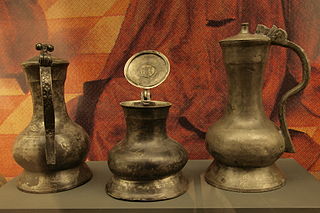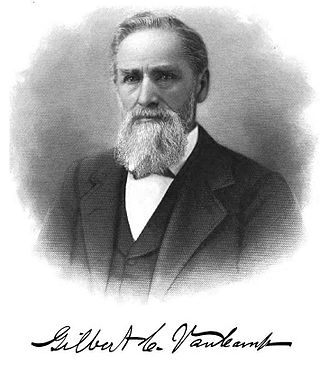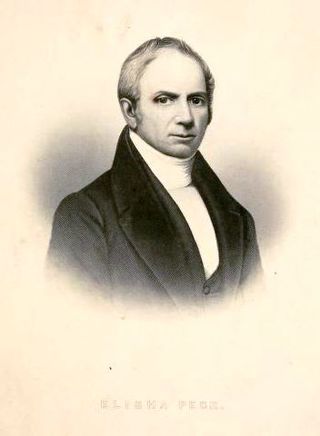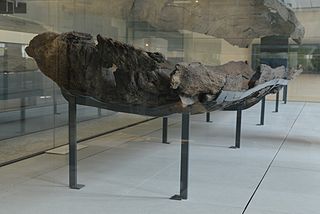
A coppersmith, also known as a brazier, is a person who makes artifacts from copper and brass. Brass is an alloy of copper and zinc. The term "redsmith" is used for a tinsmith that uses tinsmithing tools and techniques to make copper items.

Scrimshaw is scrollwork, engravings, and carvings done in bone or ivory. Typically it refers to the artwork created by whalers, engraved on the byproducts of whales, such as bones or cartilage. It is most commonly made out of the bones and teeth of sperm whales, the baleen of other whales, and the tusks of walruses.

A metalsmith or simply smith is a craftsperson fashioning useful items out of various metals. Smithing is one of the oldest metalworking occupations. Shaping metal with a hammer (forging) is the archetypical component of smithing. Often the hammering is done while the metal is hot, having been heated in a forge. Smithing can also involve the other aspects of metalworking, such as refining metals from their ores, casting it into shapes (founding), and filing to shape and size.
Tinplate consists of sheets of steel coated with a thin layer of tin to impede rusting. Before the advent of cheap milled steel, the backing metal was wrought iron. While once more widely used, the primary use of tinplate now is the manufacture of tin cans.

The Iron Act, also called the Importation, etc. Act 1749, was an Act of the Parliament of Great Britain, which was one of the legislative measures introduced within the system of Trade and Navigation Acts. The Act sought to increase the importation of pig and bar iron from its American colonies and to prevent the building of iron-related production facilities within these colonies, particularly in North America where these raw materials were identified. The dual purpose of the Act was to increase manufacturing capacity within Great Britain itself, and to limit potential competition from the colonies possessing the raw materials.

A tinsmith is a person who makes and repairs things made of tin or other light metals. The profession may sometimes also be known as a tinner, tinker, tinman, or tinplate worker; whitesmith may also refer to this profession, though the same word may also refer to an unrelated specialty of iron-smithing. By extension it can also refer to the person who deals in tinware, or tin plate. Tinsmith was a common occupation in pre-industrial times.

Tinning is the process of thinly coating sheets of wrought iron or steel with tin, and the resulting product is known as tinplate. The term is also widely used for the different process of coating a metal with solder before soldering.
The following outline is provided as an overview of and topical guide to crafts:

Lahıc is a village and municipality on the southern slopes of Greater Caucasus within the Ismailli Rayon of Azerbaijan. Population is approximately 860 people who speak the Tat language, also known as Tati Persian, a Southwestern Iranian language spoken by the Tats of Azerbaijan and Russia.

Tinware is any item made of prefabricated tinplate. Usually tinware refers to kitchenware made of tinplate, often crafted by tinsmiths. Many cans used for canned food are tinware as well. Something that is tinned after being shaped and fabricated is not considered tinware. Similar industrial products are called tin-sheet products or tinwork.
Park House is a historic house museum, located in Amherstburg, Ontario, Canada. It was built in 1796 in Detroit, but moved to Amherstburg in 1799. It has had many owners, the best-known being the Park family who owned it 102 years. In 1972 it was purchased by the Rotary Club of Amherstburg, becoming a local history museum and being renovated to portray life in the 1850s.

Lang Pioneer Village Museum is a living history museum located in the hamlet of Lang in Peterborough County, Ontario. It was established in 1967 by the County of Peterborough. Lang Pioneer Village is situated on the shores of the historic Indian River. Lang Pioneer Village is an "outdoor museum" featuring more than 30 restored and furnished buildings, many of which were donated from the surrounding townships. The buildings, constructed between 1820 and 1910, are interpreted by costumed villagers portraying authentic 19th-century pioneer life. Since 2014 the Museum has been the site of the Aabnaabin Encampment, a pre-colonization representation of a Michi Saagiig camp where the story of the First Nations history and culture of the region is told by indigenous interpreters. Lang Pioneer Village Museum is owned and operated by the County of Peterborough.

The Harwood Museum of Art is located in Taos, New Mexico. Founded in 1923 by the Harwood Foundation, it is the second oldest art museum in New Mexico. Its collections include a wide range of Hispanic works and visual arts from the Taos Society of Artists, Taos Moderns, and contemporary artists. In 1935 the museum was purchased by the University of New Mexico. Since then the property has been expanded to include an auditorium, library and additional exhibition space.

Gilbert C. Van Camp was an Indianapolis businessman who founded the Van Camp canning company.

Venturina Terme is a frazione of the comune of Campiglia Marittima . Formerly known as Venturina, it was renamed as Venturina Terme since 1 January 2014 for the importance of its thermal activities.

Elisha Peck (1789-1851) was a Massachusetts-born merchant who formed a partnership with Anson Green Phelps. He ran the British side of their business from Liverpool for about thirteen years. The partnership ended in 1834 after an accident at their New York warehouse claimed the lives of seven people. Their assets were divided and Peck took ownership of the metal manufacturing plants at Haverstraw, New York. Phelps continued with the mercantile business that he had developed with Peck, forming a new company called Phelps Dodge.
Akhisar Museum is a museum in Turkey
Ann Butler (1813–1887) was an American tin painter. Her career represents one of the few artistic occupations felt to be suitable for young women during the 19th century.
Esther Stevens Brazer was an American historian, noted especially for her interest in painted tinware.

The Pirogues de Bercy are a group of dugout canoes dating from the Neolithic period that were discovered in 1989 during construction work in the 12th arrondissement, a neighbourhood located in southeastern Paris. The excavations of 1991–1992 unearthed two lodgings from the middle Neolithic period and one from the Late Neolithic period or the early Bronze Age. The dugouts were found at the base of these lodgings, along with other Neolithic artifacts such as pottery, stone and bone tools and arrow heads.













